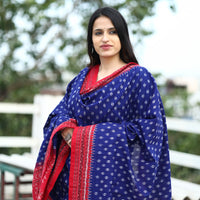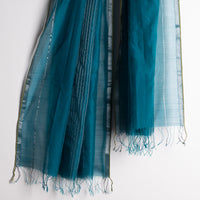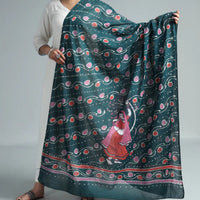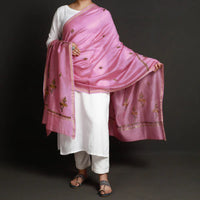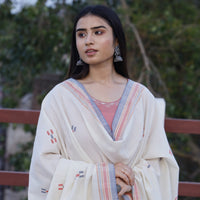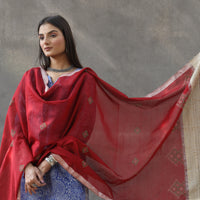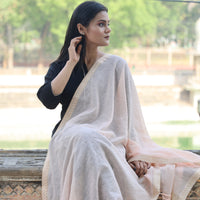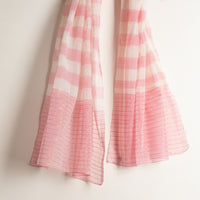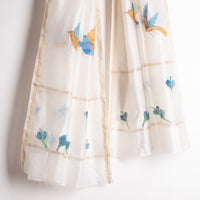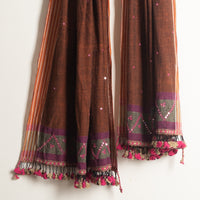History of the Craft – Pen Kalamkari Hand-Painted Art
Pen Kalamkari is one of the most intricate and ancient art forms from India, originating in the temple town of Srikalahasti in Andhra Pradesh. The word "Kalamkari" is derived from two Persian words – "Kalam," meaning pen, and "Kari," meaning craftsmanship. The essence of this art lies in using a bamboo or date palm stick with a bundle of fine hair attached to it as a brush. This traditional technique brings hand-painted stories to life on fabric.
Historically, Kalamkari was used to narrate mythological tales and stories of gods and goddesses, with many pieces depicting scenes from the Mahabharata and Ramayana. The meticulous process involves drawing intricate patterns with natural dyes on fabric, which are made using plant extracts and minerals. This eco-friendly practice ensures that each piece is sustainable and safe for the environment.
The Srikalahasti style of Pen Kalamkari is revered for its freehand drawing, where artisans bring stories to life using vivid natural dyes. The process involves multiple stages—each piece is washed, sun-dried, treated with cow dung, and then drawn and painted by hand. This labor-intensive process takes days to complete, making every Pen Kalamkari dupatta a one-of-a-kind masterpiece.
At iTokri, we work with skilled artisans who carry forward this tradition with passion and dedication. Our collection of Pen Kalamkari dupattas celebrates this age-old craft, offering unique designs that reflect India’s artistic heritage.
History of the Dupatta and Sub-Categories at iTokri
The dupatta is an integral part of traditional Indian attire. Its origins trace back to the ancient Indian subcontinent, where it was worn as a symbol of grace and modesty. Over the centuries, the dupatta has evolved from a simple head or shoulder covering into a versatile fashion accessory that enhances any outfit. It has become an essential part of ensembles like lehengas, salwar kameez, and sarees.
The Pen Kalamkari Dupatta stands out because of its intricate hand-painted designs and natural dye palette, offering a unique blend of tradition and artistry. Whether you’re attending a wedding, festival, or casual gathering, Pen Kalamkari dupattas add a touch of elegance and cultural depth to your wardrobe.
At iTokri, we offer various types of dupattas, each representing a different regional craft and artistic tradition. Apart from Pen Kalamkari, our collection includes:
Ajrakh Block Prints Dupattas – Known for their intricate geometric patterns, crafted using natural dyes.
Sanganeri Printed Dupattas – Floral motifs and vibrant colors from Rajasthan.
Bandhani Tie-Dye Dupattas – Another popular tie-dye technique featuring tiny knots and patterns, symbolic of Indian festivities.
Batik Printing Dupattas – Earthy tones and natural dyes, block printed by artisans from Rajasthan.
Bagru Dabu Block Print Dupattas – Earthy tones and natural dyes, block printed by artisans from Rajasthan.
Leheriya Tie-Dye Dupattas – Known for their wave-like patterns and bright colors, a traditional tie-dye from Rajasthan.
By offering a wide selection of dupattas, iTokri ensures that each customer finds something that resonates with their personal style and cultural appreciation.
Other Kalamkari Hand-Painted Products at iTokri
Beyond dupattas, Kalamkari as a craft finds expression in various forms, and iTokri proudly showcases these other handcrafted products. Our Pen Kalamkari fabrics are perfect for those looking to create their own garments or home decor items using this intricate craft. We also offer Kalamkari sarees, which are popular for their elaborate hand-drawn designs and eco-friendly nature.
For customers who appreciate handcrafted accessories, our Kalamkari stoles provide an elegant alternative to dupattas, offering versatility and style for both casual and formal occasions. Kalamkari's timeless appeal also extends to Kalamkari kurtas and blouses, allowing wearers to showcase this beautiful art in their everyday attire.
In addition to the Pen Kalamkari products, iTokri offers similar handcrafted items in other crafts such as Bagru Block Prints, Ajrakh, and Bandhani, making it easy to explore and connect with different Indian crafts.
Other Primary Product Categories at iTokri
iTokri is more than just a platform for dupattas; it offers a curated selection of handcrafted goods representing India's diverse cultural heritage. Our primary product categories include:
Women’s clothing and accessories: This includes a wide variety of sarees, kurtas, stitched suits, skirts, and dresses. Each piece is handcrafted and represents traditional crafts such as block printing, embroidery, and hand weaving.
Fabrics and dress materials: Ideal for those who love tailoring their own outfits, our fabric collection features handloom fabrics, batik prints, hand block prints, and Kalamkari designs.
Men’s wear: We offer a curated range of handwoven kurtas, shirts, and accessories for men, each showcasing India’s diverse textile traditions.
Home & Décor: Our home decor section offers an assortment of products, from bed covers to cushion covers, all handmade with traditional techniques. Add an authentic touch to your living spaces with our artisan-crafted pieces.
Jewellery & Accessories: Our jewelry collection features unique, handmade pieces created by local artisans. This includes necklaces, earrings, bracelets, and more.
Bags & Stationery: Explore our range of eco-friendly bags and handcrafted stationery, perfect for gifting or personal use.
Each product at iTokri reflects the brand’s commitment to sustainability, ethical trade, and support for artisans, offering customers a conscious shopping experience.
Why Choose iTokri for Shopping Crafts?
Since 2012, iTokri has been a trusted name in sourcing authentic handcrafted products from India. Our dedication to preserving India’s cultural heritage and supporting artisans sets us apart. We work directly with over 500 artisan groups, ensuring fair wages, ethical practices, and sustainability in every step of the production process.
iTokri’s customer service goes beyond transactions—we foster a personal connection with each customer, reflected in our eco-friendly packaging, handwritten notes, and thoughtful touches with every order. Our policies on Returns & Cancellations, Shipping, Payments, and International Orders ensure a smooth and transparent shopping experience.
By choosing iTokri, you join a community of like-minded individuals who believe in fair trade, ethical sourcing, and the importance of preserving cultural crafts. To learn more about our values, artisans, or policies, explore our ARTISANS, CRAFTS OF INDIA, and ETHICAL TRADE pages. Connect with us via Blog, Social Reviews, or get in touch with our team through the Contact Us page.
Explore our vast collection today and bring home a piece of India’s rich artisanal heritage!
Frequently Asked Questions (FAQ) about Srikalahasti Kalamkari Dupattas
1. What is a Pen Kalamkari Dupatta?
-
- A Pen Kalamkari Dupatta is a traditional Indian scarf hand-painted using a pen (kalam) with natural dyes. It originates from Srikalahasti, Andhra Pradesh, and showcases intricate designs inspired by mythological and cultural themes.
2. How is Pen Kalamkari different from other Kalamkari styles?
-
- Pen Kalamkari involves freehand drawing with a pen and natural dyes, making each design unique and intricate. It differs from block-printed Kalamkari in that it is entirely hand-drawn, requiring greater skill and time.
3. Where can I buy authentic Pen Kalamkari dupattas online?
-
- You can shop authentic Pen Kalamkari dupattas online at iTokri, where we offer a curated selection of hand-painted pieces, created by master artisans from Srikalahasti.
4. Are Pen Kalamkari dupattas eco-friendly?
-
- Yes, Pen Kalamkari dupattas are eco-friendly. They are made using natural dyes derived from plants and minerals, making them safe for the environment and sustainable for everyday use.
5. What materials are used in Pen Kalamkari dupattas?
-
- Pen Kalamkari dupattas are crafted from natural fabrics such as cotton and silk. At iTokri, you’ll find both pen kalamkari silk dupattas and cotton options, each offering a unique texture and drape.
6. How do I care for my Pen Kalamkari Dupatta?
-
- To maintain the quality and vibrancy of your hand-painted kalamkari dupatta, hand wash it in cold water using mild detergent. Avoid harsh chemicals and direct sunlight to preserve the natural dyes.
7. Can I wear a Pen Kalamkari dupatta for special occasions?
-
- Absolutely! Pen Kalamkari dupattas are perfect for festivals, weddings, and special occasions due to their intricate designs and rich cultural heritage. Pair them with traditional attire to make a statement.
8. What other products are available in the Kalamkari craft?
9. How long does it take to create a Pen Kalamkari dupatta?
-
- The process of making a Pen Kalamkari dupatta is labor-intensive and can take several days. Each stage, from preparing the fabric to hand-painting the designs and applying multiple layers of natural dye, requires time and skill.
10. Why choose iTokri for Pen Kalamkari Dupattas?
-
- iTokri offers authentic, hand-painted Pen Kalamkari dupattas directly sourced from artisans in Srikalahasti. Our commitment to fair trade, eco-friendly practices, and artisan support ensures that each piece you buy contributes to sustaining traditional Indian crafts.









